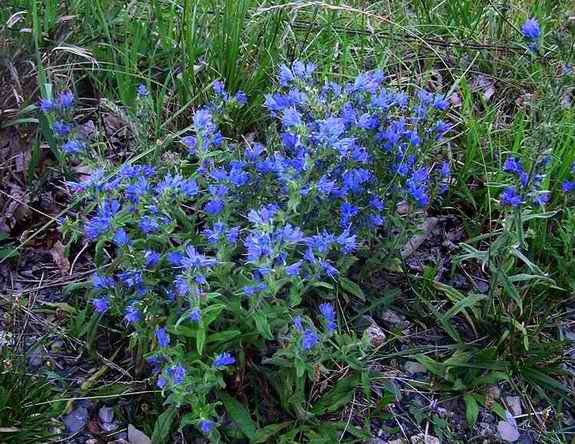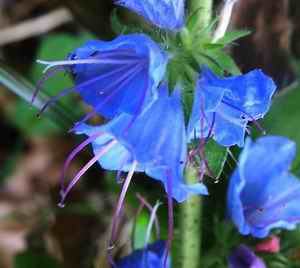|
Return to the Hiker's Notebook Home Page
Common Name: Viper's Bugloss, Blueweed, Blue-devil, Blue thistle, Blue Echium - The name Bugloss has survived several cultural translations: buglosse in French, buglossa in Latin and bouglossos in Greek. Its original genesis is the two Greek words bous, which means the head of a cow and glossa, meaning tongue. This refers to the hairy and spiny leaves that are "as coarse as a cow's tongue." The distinguishing term "viper's" is added to distinguish this plant as the specific bugloss with fruits or nutlets that have the shape of a viper's head.
Scientific Name: Echium vulgare - The generic name is probably from the Greek word for viper, echis. This would seem to be appropriately consistent with the common name Viper's Bugloss; however, as it is the genus and not the species name, this etymology is suspect. Echion appears in Greek mythology as the name of one of the Spartan warriors who sprang from the dragon's teeth sown by Cadmus. Historically, Echion was a painter in the 4th Century BCE. Alternatively, Echius was a Trojan warrior slain by Patroclus, the companion of Achilles according to the Iliad. Vulgare is from the Latin vulgaris, meaning common, ordinary or usual. Viper's bugloss was introduced to the North America from Europe in the 17th Century; it has taken on the status of a noxious weed in some areas, notably the state of Washington. It is a native to most of Europe and western and central Asia; its distinguishing brilliant hues make it an easily identified and well-known species. The beauty of the florescence belies its pestilential association; it is ironic that the burned root was used for charcoal by artists. It goes by many names, most of which emphasize the brilliant blue: lan ji, or "blue luck" in China; gew�hnlicher natternkopf or "common viper head" in Germany; himmelbrand or "sky-fire" and stolzer (proud) Heinrich in Austria; and sinyak obryknovenny, or "common blue" in Russian (blue here is a colloquial word like the "black and blue" of a bruise). It is in all cases considered to be a very common blue flower.
Viper's Bugloss has been used as a folk medicine for centuries, its ubiquity and resplendence likely inspiring experimentation. The viper-headed seeds suggested a use against snakebite according to the Doctrine of Signatures, a belief first espoused by Paracelsus in the 16th Century; God placed plants on earth for humans and indicated their use with an identifiable sign. William Cole offered that "Viper's Bugloss hath its stalks all to be speckled like a snake or a viper, and is a most singular remedy against poyson and the sting of scorpions" in his 1656 work "The Art of Simples" (medicinal herbs were called Simples, as the practice of using herbs medicinally was called Simpling). Any benefit that Viper's Bugloss might impart to a snakebite victim would be largely due to the placebo effect.
Viper's Bugloss was also used as a "simple" for the treatment of a variety of ailments more mundane than snakebite; there may be some credence to its efficacy in these applications. John Parkinson, the apothecary to King James I of England (aka King James VI of Scotland), wrote in his seminal "Theatrum Botanicum: The Theater of Plants, or, An Herbal of a Large Extent" that "the water distilled in glasses or the roote itself taken is good against the passions and tremblings of the heart as also against swoonings, sadness and melancholy." The treatment consisted of drying the leaves taken from near the bottom of the plant and making a tea by placing an ounce of the resultant powder in a pint of boiling water. The effect was to promote the purging of liquids in sweating, expectoration and diuresis. The net result was a diminution of fever, headaches, and other "nervous complaints." It fell into desuetude as a medicinal in part due to the decline of nature herbs in the pharmacopoeia and in part due to its potential toxicity.
Viper's Bugloss contains relatively small amounts of pyrrolizodine alkaloids that make the plant toxic to livestock and to humans. These compounds are called hepatotoxic due to their deleterious effect on the liver. Instances of human illness due to these alkaloids are rare and have occurred primarily as a result of medicinal teas made from plants that have relatively high levels of the compound, like comfrey (Symphytum officinale). Symptoms include nausea, abdominal pain, fever, and jaundice as a biochemical indication of liver dysfunction; death can result in several weeks if consumption is sustained. Similar symptoms are manifest in range animals that consume the plant, sometimes inadvertently mixed in with other silage. Another manifestation of the toxicity is that the hairs of the stem impart contact dermatitis to humans. |

